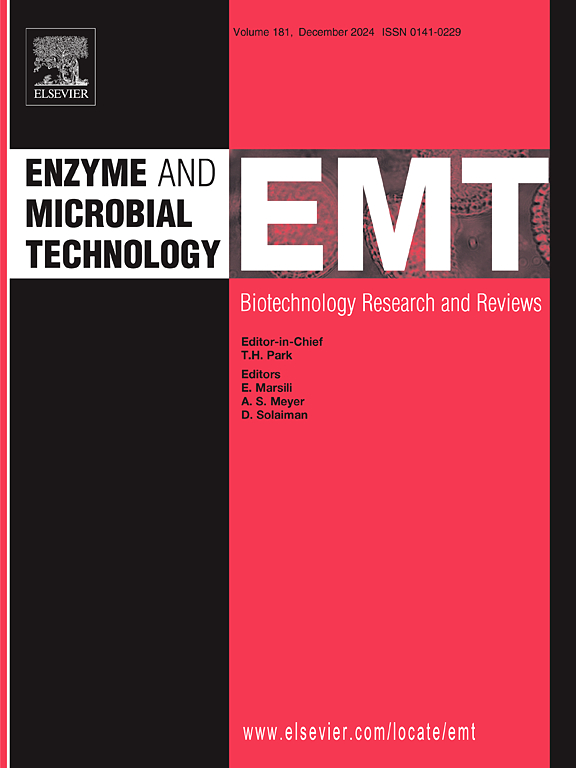Mechanism of tyrosine 69 in the flavin domain modulating electron transfer efficiency in BVU5 azoreductase
IF 3.7
3区 生物学
Q2 BIOTECHNOLOGY & APPLIED MICROBIOLOGY
引用次数: 0
Abstract
The azoreductase BVU5 is a flavoprotein dependent on NAD(P)H/FMN-mediated electron transfer; However, the functional mechanism of key residues within its flavin domain remains unclear. This study identified the conserved residue Tyr69 through bioinformatics analysis and constructed Y69F and Y69C mutants. Enzymatic assays demonstrated that mutants exhibited significantly lower decolorization rates than the BVU5 enzyme across 12 dye molecules, including azo, anthraquinone, and triphenylmethane dyes. For example, when decolorizing Reactive Black 5 (RB5) for 2 h: Y69F mutant achieved 60 %-65 % decolorization, Y69C mutant reached 55 %-60 % decolorization, both markedly lower than the 80 %-85 % efficiency of BVU5.The decolorization hierarchy remained azo dyes > triphenylmethane > anthraquinone dyes. Molecular docking revealed that mutations reconfigured FMN-binding patterns. Although Y69F enlarged the substrate-binding pocket, it failed to enhance the degradation efficiency of the bulky dye Chlorazol Black E. This critical contradiction indicates that substrate binding is not the limiting factor. Combined with evidence such as the lighter color of the mutant enzyme solutions, increased A280/A450 ratios, and enzyme dosage experiments, this study confirms that Tyr69 is a key residue that sustains electron transfer efficiency by maintaining the FMN-binding conformation, thereby determining the decolorization performance. Consequently, electron transfer efficiency, rather than substrate binding, is the primary mechanism influencing the catalytic function of BVU5.
黄素区域酪氨酸69调节BVU5偶氮还原酶电子转移效率的机制
偶氮还原酶BVU5是一种依赖于NAD(P)H/ fmn介导的电子转移的黄蛋白;然而,其黄素结构域关键残基的功能机制尚不清楚。本研究通过生物信息学分析鉴定了保守残基Tyr69,构建了Y69F和Y69C突变体。酶分析表明,突变体在12种染料分子上的脱色率明显低于BVU5酶,包括偶氮、蒽醌和三苯甲烷染料。例如,当2 h: Y69F突变体对活性黑5 (RB5)脱色时,脱色率为60 %-65 %,Y69C突变体脱色率为55 %-60 %,均明显低于BVU5的80 %-85 %。脱色等级仍为偶氮染料>; 三苯甲烷>; 蒽醌染料。分子对接显示突变重新配置了fmn结合模式。虽然Y69F扩大了底物结合袋,但未能提高对体积较大的染料氯唑黑e的降解效率,这一关键矛盾表明底物结合并不是限制因素。结合突变酶溶液颜色变浅、A280/A450比值增加、酶用量实验等证据,本研究证实Tyr69是通过维持fnm结合构象来维持电子转移效率的关键残基,从而决定了脱色性能。因此,电子转移效率,而不是底物结合,是影响BVU5催化功能的主要机制。
本文章由计算机程序翻译,如有差异,请以英文原文为准。
求助全文
约1分钟内获得全文
求助全文
来源期刊

Enzyme and Microbial Technology
生物-生物工程与应用微生物
CiteScore
7.60
自引率
5.90%
发文量
142
审稿时长
38 days
期刊介绍:
Enzyme and Microbial Technology is an international, peer-reviewed journal publishing original research and reviews, of biotechnological significance and novelty, on basic and applied aspects of the science and technology of processes involving the use of enzymes, micro-organisms, animal cells and plant cells.
We especially encourage submissions on:
Biocatalysis and the use of Directed Evolution in Synthetic Biology and Biotechnology
Biotechnological Production of New Bioactive Molecules, Biomaterials, Biopharmaceuticals, and Biofuels
New Imaging Techniques and Biosensors, especially as applicable to Healthcare and Systems Biology
New Biotechnological Approaches in Genomics, Proteomics and Metabolomics
Metabolic Engineering, Biomolecular Engineering and Nanobiotechnology
Manuscripts which report isolation, purification, immobilization or utilization of organisms or enzymes which are already well-described in the literature are not suitable for publication in EMT, unless their primary purpose is to report significant new findings or approaches which are of broad biotechnological importance. Similarly, manuscripts which report optimization studies on well-established processes are inappropriate. EMT does not accept papers dealing with mathematical modeling unless they report significant, new experimental data.
 求助内容:
求助内容: 应助结果提醒方式:
应助结果提醒方式:


